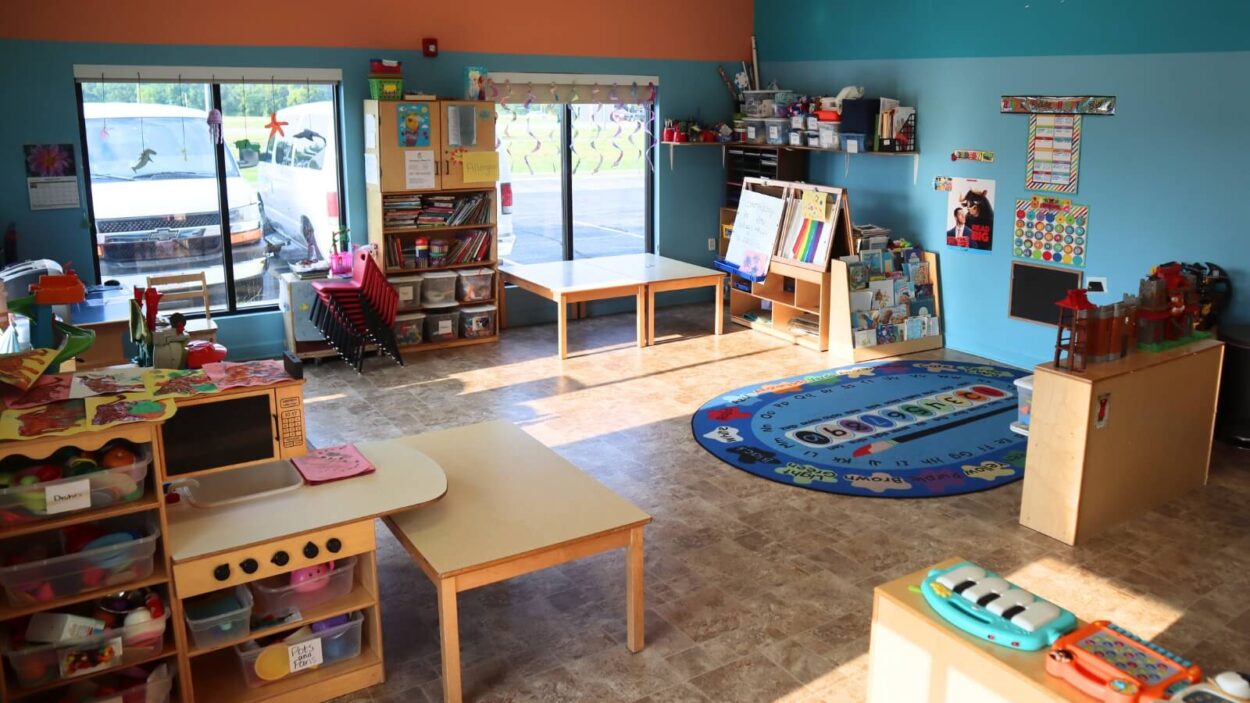As a parent, when you drop your child off at daycare or preschool, you don’t want to have to worry about whether or not they’re getting the care that they need. That’s why, before enrolling your little one in a program, it’s important to ask questions such as: “What is your ratio of staff-to-children?”
In a perfect world, daycares would have a 1:1 ratio of one caregiver for every child. (That way, you can be certain your child gets showered in the undivided attention you want them to have!) Unfortunately, however, that is rarely the case for most daycares and preschools—but certain childcare ratios are still legally required by each state.
Read on to learn what the perfect child-to-caregiver ratio is for each age group, so you know what to look out for when trying to determine whether or not a daycare or preschool is the right fit for your kid.
What’s a Good Child-to-Caregiver Ratio?
| Child’s Age | Staff to Child Ratio | Maximum number of children in group/class |
| Newborn to 2 Years Old | 1:4, 1 trained adult per 4 children | No more than 8 children in a group. |
| 2 to 2.5 Years Old | 1:6, 1 trained adult per 6 children | No more than 12 children in a group. |
| 2.3 to 3 Years Old | 1:8, 1 trained adult per 8 children | No more than 16 children in a group. |
| 3 Years Old | 1:10, 1 trained adult per 10 children | No more than 20 children in a group. |
| 4 Years Old | 1:13, 1 trained adult per 13 children | No more than 24 children in a group. |
| 5 Years Old | 1:17, 1 trained adult per 17 children | No more than 34 children in a group. |
| 6+ Years Old | 1:18, 1 trained adult per 18 children | No more than 36 children in a group. |
In the state of Wisconsin, the state requirements for child-to-caregiver ratios are approved by the Wisconsin Department of Health Services and are meticulously designed to provide optimal care and attention to the unique needs of each age category.
Starting with newborns up to 2-year-olds, the staff-to-child ratio is set at 1 trained adult per 4 children, with a maximum group size of 8 children. As children progress to the 2 to 2.5-year-old range, the staff-to-child ratio adjusts to 1:6, with a corresponding maximum group size of 12 children. This pattern continues as children grow older, with specific ratios and group size limits for each age group. For instance, for 2.5 to 3-year-olds, the ratio becomes 1:8, with a maximum of 16 children in a group.
By the time children reach 4 years old, the staff-to-child ratio becomes 1:13, and the maximum group size is set at 24 children. These ratios and group size limits extend through the subsequent age groups, such as 5 years old (1:17, maximum 34 children in a group) and 6+ years old (1:18, maximum 36 children in a group).
This thoughtful progression ensures that as children develop, they receive appropriate supervision and support from trained adults. Younger children, for example, will need more attention, thereby requiring more caregivers, while older children are capable enough to operate on their own and require less. (Of course, no matter how old they are, they’ll still be under a watchful eye!)
The careful calibration of these ratios and group sizes can be a reflection of a childcare facility’s commitment to maintaining a nurturing environment that fosters individualized growth and well-being. That’s why we recommend that the daycare you choose offers child-to-caregiver ratios that are similar to the ones we have provided above.
Why is It Important to Follow Child-to-Caregiver Ratios?

Enhanced Safety
Proper supervision is the key to reducing the risk of accident or injury. That’s why child-to-caregiver ratios are so crucial; they allow caregivers to actively watch, listen, and respond to children’s urgent (and non-urgent) needs. This is especially important when kids are eating, playing, or moving between areas, as those situations can pose the most hazards to young children.
Developmental Support
In order for your child to reach all their developmental milestones, they need to be in an environment that supports them both socially, emotionally, and educationally. This is easier in daycares or preschools that follow child-to-caregiver ratios, as the caregivers are able to provide each child with individualized attention that is tailored to their unique needs.
If your child needs help with reading, for example, the caregiver can help them during lessons; if they need help making friends, the caregiver can encourage them during playtime. This is not always easy, however, if the caregiver is watching over too many children, and doesn’t have the time to personalize each one’s experience.
Less Caregiver Burnout
Caregivers are people too, and if their child-to-caregiver ratio is too high, they’re more likely to experience burnout. As a parent, you know taking care of young kids isn’t always easy—now try imagining handling six or more, all at one time! This burnout can eventually result in a high turnover rate at a daycare or preschool, preventing the children from creating a close connection with their caregiver.
Even if the caregivers don’t end up experiencing burnout and leave their position, poor child-to-caregiver ratios can affect the quality of care. That’s because the caregivers are more likely to become stressed and overwhelmed, and the sheer number of kids prevents them from providing your child with personalized support.
Experience High Quality Care at Cornerstone

At Cornerstone Academy, we are proud to adhere to the recommended child-to-caregiver ratios to provide our kids with the support they need! We want to make sure your child is safe, comfortable, and receiving all the assistance they need to grow. To learn more about the child-to-caregiver ratio at Cornerstone Academy and our current enrollment opportunities, fill out our online form or give us a call at (262) 552-5368.




